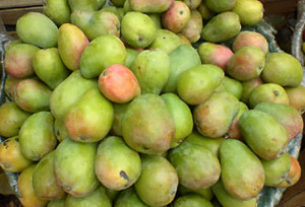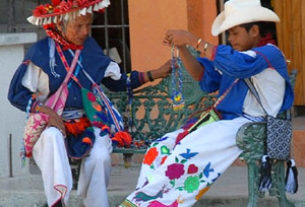The amazing phenomena of the Monarch butterfly migration is with us again. At the end of summer hundreds of millions of monarchs fly an incredible average of 1,800 miles from the United States and Canada to a small region in nearby Michoacan where they spend the winter before embarking on the return journey. Some of us may have witnessed part of it, perhaps a swarm of butterflies crossing a Texas highway, or swooping over a New York skyscraper or even here in San Miguel resting on a few favored trees.
Although the migration from the Rocky Mountains to the California coast was known about as early as the 30’s, the eastern migration remained a mystery until January 2, 1975. Hundreds of millions of monarchs living between Canada and Florida apparently just disappeared. Many scientists discounted the theory that they migrated, arguing that the butterflies lacked not only the size and sturdiness of birds, but also the necessary life-span. (Many birds migrate several times in their life and some believe that older birds play a role in guiding flocks to their destination.) Shorter-lived butterflies would need instinct to survive and arrive.
In 1935 a Toronto based entomologist, Fred Urquhart started a life-long search for the missing Monarchs. Scientists had already successfully investigated migrating birds by tagging them. However, it is one thing to tag a gull, and quite another to tag a less than 500milligram butterfly. It was not until the mid 50’s that Urquhart came up with a tag – not unlike a small supermarket sticker that would stay put and not interfere with the monarch’s ability to fly.
Over the next ten years or so he had gathered, along with a growing team of volunteer helpers ranging from scientists to children, enough information to know that the monarchs flew some 1000 miles towards the Mexican border. However then he reached a dead end. 200 million butterflies seemed to disappear into a Bermuda triangle type area somewhere South of the Rio Grande.
Although researchers, including Urquhart spent years looking south of the border, they found nothing until on November 6, 1973 they had a breakthrough. Ken Brugger, an American living in Mexico City was driving through Michoacan when a hail storm forced him to pull off the road. He got out of the car because something unbelievable was happening. It was hailing monarchs! Ken had read about Urquhart’s work in the Daily News and knew that the answer to the monarch mystery had to be nearby.
The reason Ken was in that area at all was that he had been searching for a student called Cathy Aguado. He found her, asked her to marry him, she accepted and they discovered that they shared this interest in butterflies. So they began an arduous search, later financed by Urquhart, for the evasive winter retreat of the monarchs. Braving mud-slides and aggressive gun-slinging locals who thought they were after the legendary treasure of revolutionary Emiliano Zapata they criss-crossed the mountains of Michoacan.
Finally they focused their attention on Cerro Pelón (Bald Mountain). Day after day they scaled different slopes, until one morning a lone monarch fluttered down the mountain slope. Butterflies don’t fly at night so they knew it had to have come from further up. Pressing onwards and upwards they discovered not tens of thousands but tens of millions of monarchs hanging from the tree trunks and branches, carpeting the forest floor and even the Bruggers themselves.
Miraculously, amongst all these millions of butterflies Ken almost immediately found a monarch that had been tagged by a 13-year old Texan, John McClusky, using an improvised tag. The mystery was, at last, solved!
Since then a further eight winter colonies of the monarch have been found in a 75 by 35-mile area near Zitacuaro in Michoacan. Each colony is in a tiny forest grove varying in size between a baseball diamond and a large city block.
Cathy Brugger described the moment of discovery: “I could not speak. I was just frozen and my heart was beating so fast…What a marvelous thing this was. And I wished, at that moment, that all people could feel what I was feeling: the magnificence of the butterflies.”
The monarch is not only unusual for being one of the few insects that migrate. The monarch is actually a tropical animal, yet during the warmer months it is found as far north as James Bay in Canada. It is the only species of this general type of butterfly that has spread outside the tropics.
Monarchs are nearly always found where milkweed grows, because the milkweed leaf is the only food that the monarch caterpillar eats. Many scientists say that the cardenolides contained in milkweed are poisonous to most potential predators thus protecting the spectacularly colored monarchs. According to these scientists viceroy butterflies mimic the colors of the monarch to protect them from predators who presume they are poisonous too.
The mother butterfly lays as many as 600 eggs, each one on the underside of a separate milkweed leaf, of which only a few survive. Within days the larva or caterpillar hatches from the speck-sized egg and begins to eat . . .and eat. It eats so much that its skin breaks open four times and the caterpillar emerges – eating – in a new suit.
After two weeks, 3000 times heavier than when it hatched, it is ready for metamorphosis. The mature caterpillar spins a silk button from a gland below its jaws onto a twig and hangs from it by its back legs. After a few hours, the skin splits again and a black hook grabs hold of the silk button, whilst the legs, mouth and antennae also fall off leaving the chrysalis. The jade-colored chrysalis becomes transparent over the next ten days until suddenly, in about 80 seconds, the freshly born butterfly emerges.
It is not ready to fly until it has pumped fluid into its crumpled wings and then let them dry. However not all the new-born butterflies are the same.
The monarch that hatches in the late summer is very different from the butterfly that hatched only a few weeks before. Unlike its parents the autumn butterfly does not remain near its birthplace. Almost immediately it begins to migrate, stopping only to feed or to rest at night or in bad weather.
Spring and summer monarchs on the other hand keep to what they consider their territory and will even attack birds that wander into their patch. Although the monarch has nothing to attack with, it dazzles the intruding birds by wildly flapping its wings and confusing them.
Another difference is that the autumn monarchs cannot mate. Their sexual organs do not develop until the following spring thousands of miles away.
The migrant monarchs will live 7-12 times longer than their non-migrant relatives. They spread their wings to collect heat from the sun and then fly by successively flapping their wings and gliding. They cover about 80 miles a day at a speed of up to 20 (or even 30) miles per hour, though the average is 12 mph. They can fly at heights of up to 2 miles high.
They reach their colonies in Michoacan at the end of November. Their favorite tree is the oyamel, whose needle-like leaves are ideal for the monarch’s hooked legs to cling onto. The trunks and branches are so thickly coated with butterflies that sometimes the combined weight of these delicate creatures break the branches! The only parts of the tree they don’t cover are the colder tops and the bottoms where hungry mice threaten.
Why should they have chosen as their destination the seemingly inhospitable mountains of Michoacan, two miles above sea-level? The temperature is generally below the 55° F. needed for flight so the monarchs are paralyzed by the cold most of the time.
There is reason behind this apparent madness. The fact that it is too cold to fly means that they do not waste vital reserves of fat. That would be disastrous because they need all the fat they can store for the end of February and March when they have to mate and fly north. Also, it rarely freezes, which would kill them.
In March, after the frenzy of mating they restart their journey and fly almost without stopping. The clock is ticking. Once their sexual organs have fully developed they, like spring monarchs, only have four weeks to live.
Although some of the hardier ones may reach the northern States of the U.S.A. to lay eggs, it is thought most likely that returning monarchs lay their eggs in Texas, Louisiana and Alabama in April and May. This conclusion was reached by correlating chemical studies of the monarchs with the location of different varieties of milkweed.
If correct, this result implies that the second generation monarch also migrates!, though this time only from the south to the north of the States.
The biggest puzzle is, how do they find their way? Some migrating animals use the sun, the stars, the sound of the sea and smells to guide them. Monarchs possibly use the position of the sun as a compass, but they do not stray from their course even when the sun is not visible, so they must have another guiding mechanism as well. It is hypothesized that the small quantities of magnetite in their bodies allow them to sense changes in the earth’s magnetic field and thereby navigate. Local legend in Michoacan holds that the high quantities of magnetic iron in Angangueo gorge attract the monarchs like a magnet back to their winter homes. They could be right!
The author would like to acknowledge Ethan Herberman’s book ‘The Great Butterfly Hunt’ (presented to the Travel Institute by a satisfied tour member!)



